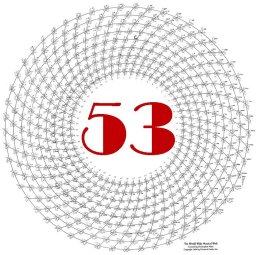Next Page: 2/11 – India & Musical Imperialism
Heroic Efforts of Hemlholtz and Colleagues
Do not be afraid to be out of tune with the piano. It is the piano that is out of tune. –cellist Pablo Casals
By the early 19th century, the music world embraced the 12-eq tuning system. Some brave composers and the scientist Hermann Helmholtz rejected the inharmonicities inherent in the “modern,” Industrial-Age, standardized tuning system. Scriabin, Busoni and other composers who were cursed with perfect pitch railed against the 12-eq tuning system, but to no avail. Helmoltz extensively studied the 53-eq template, and his followers even built 53-eq keyboard instruments, but they never caught on. Even a Japanese scientist advocated for 53-eq tuning in 1880.
Scriabin composed chords that sound fantastic in just intonation but are indeed dissonant to our ears. An example is his “Mystic Chord,” which sounds like this in 53-eq:
Feel free to explore this entire sample website to learn more about the contents of the pdf book and complete website, The Grand Unified Theory of Music. To buy a pdf copy and to get access to the full website for $25, see below.
A free introduction to what The Grand Unified Theory of Music offers is on this website and includes both text and a few musical examples from each webpage. If you would like to learn more about this chapter and the full contents of this entire e-book, you can buy The Grand Unified Theory of Music for $25, with hundreds of embedded musical examples of scales and chords from all over the world — and ideas for how to set up your computer system —
HERE.
You’ll get a personalized password you can use to see the entire e-book. Inside the full book, you will also get a link to the complete pdf file of this e-book, which you can read on your Kindle or similar device. The links to the hundreds of mp3 sound files – the same ones you can hear on the website — will also be included. This is “Version 1.0” of The Grand Unified Theory of Music. Because it is an e-book, additions, corrections and improvements in the sound may be added at any time. The Grand Unified Theory of Music is Copyright © 2018 by Christopher Mohr. All rights reserved.
One person per password. Sharing this password with others is a violation of copyright. Do not allow others to use your password or link to the pdf file!
